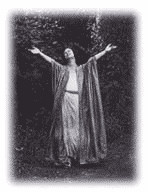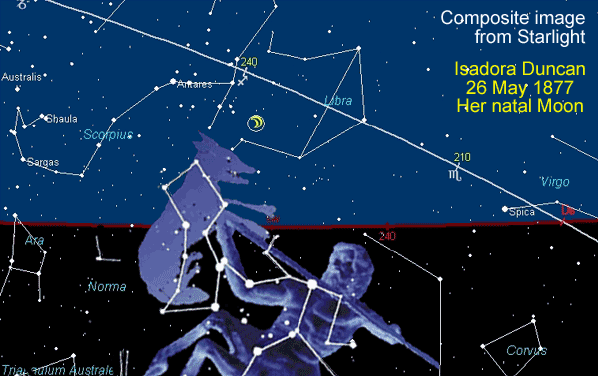Darrelyn Gunzburg
March 2006

Isadora Duncan [ 26 May, 1877 2.20 am LMT San Francisco, USA [1] is known today as the mother of “modern dance”, founding the “New System” of interpretive movement by blending poetry, music and the rhythms of nature, one of the first to raise interpretive dance to the status of creative art. Born to a poet father and a mother who taught her to “listen to the music with your soul”, Duncan was inspired by watching the waves slap and ebb on the beach and by the ideas of Francois Delsarte [2] who recognized that natural movements were those that flowed from the structure of the body and the pull of gravity. Perhaps this insistence that the force of gravity must form part of the dance was enhanced by the fact she was born when the Moon was full and being “drawn down”. (Figure right: Isadora Duncan 1919)
When stars touch the earth they are made more accessible. Could it be the same with the moon? Could we suggest that at this moment when the moon is being drawn down that gravity has temporally won in this Moon-earth dance? Whether or not this is so, it is worthwhile looking at her Moon both in the sky as well as the fixed stars which sit underneath her significant Moon, a Moon which the Greeks considered to be drawn down by witches.
Her sky map (below) for the moment of her birth shows her full moon, low to the horizon and sitting between the stars of Scorpio and the beast of Lupus, the wolf who is being killed by Centaurus, also known to astrologers as the centaur Chiron.
Beasts in mythology are killed because they are feared. So one has to ask: “Fear of what?” The relationship between wolves and people evolved in Ice Age Eurasia [3] about a hundred thousand years ago. Survival threw them together in a way that meant the wolf-human hunting relationship was governed by mutual tolerance and respect. This relationship changed when humans assumed a pastoral and agricultural life-style where growing domesticated animals for food required control and ultimately the elimination of predators such as the wolf. This was embroidered onto the sky as the story of the Centaur killing the predator Lupus. Was this the fault of the wolf or the lack of recognition of what a change of lifestyle implied?

By analogy and application to Duncan, we can hypothesize that she represented a raw wildness in her dancing, dangerous in its implication for change, yet ultimately proving that that which is to be feared brings great blessings. This was unconsciously summed up by photographer Max Eastman who is quoted as saying,
It was never easy to coax Isadora Duncan into a photographer’s studio.
Like a wild and wise animal, she fled from those who sought to capture
the essence of her – which was motion – by making her stand still.[4]
We can gain further understanding by considering one of her lunar parans:
Starlight says of Duncan’s Moon culminating when Scheat is rising
Challenging social conventions; free-thinking in the arts, cuisine and matters of care
Her life as an individual was one that would not be chained to convention. She was constantly defying social taboos. She did not believe in marriage – a huge statement for the early 20th century – and gave birth to two children from two different fathers. Inspired by her as a role model, many schools created the space for dance to become part of the curriculum, beyond exercise, a life-enhancing experience.
In conclusion
The full moon moving along the horizon is an awesome sight. Once believed to be drawn down by performance in ancient ceremonies, we can still see its expression in the charts of those who have been born at such an auspicious moment in present time by how they expressed it in their lives. Duncan’s parents named her Dora Angela. Dora is Greek in origin and means “gift”. Duncan brought with her the gift of angels in the way that she danced but perhaps the drawn down moon enhanced this gift and gave her the concrete ability to express it more clearly and succinctly, a true Thessalian witch bridging worlds to inspire and uplift us.
—————————–
(1) There are two dates for Isadora’s birth. The most astrologically accepted is from a recently-recovered baptismal record which states this as being ” 26 May 1877″, Another cites “27 May, 1878”. Interestingly these two birth dates are a year and a day apart, the traditional length of a witches’ year.
(2) Francois Delsarte (1811-1871), was a student at the Paris Conservatory. Fuelled by a hunger for more “realistic” acting, he began studying how humans actually moved, behaved and responded to a multitude of circumstances recognizing emergent expressive patterns which eventually became the Delsarte System of Expression which flooded into all levels of the culture.
http://www.delsarteproject.com/history.htm – accessed 2nd March 2006.
[3] From “Beringia Natural History Notebook Series – September, 1992”, Alaska-Hawaii Regional Office
Anchorage, Alaska: http://www.nps.gov/bela/html/wolves.htm – accessed 2nd March 2006.
[4] Isadora Duncan Dance Foundation: http://www.isadoraduncan.org/about_isadora.html – accessed 2nd March 2006.




